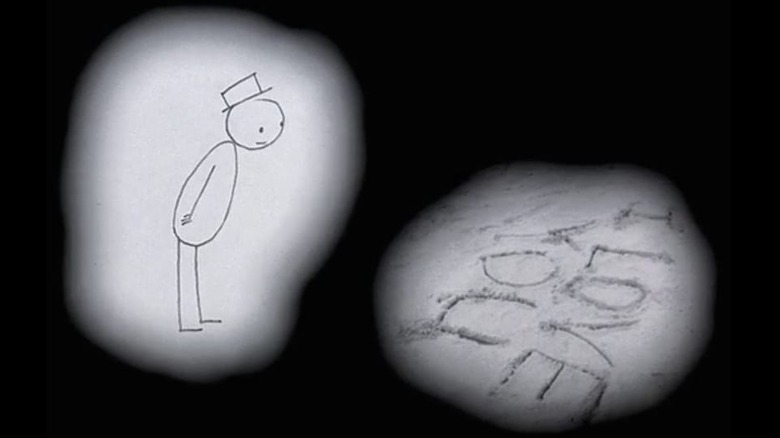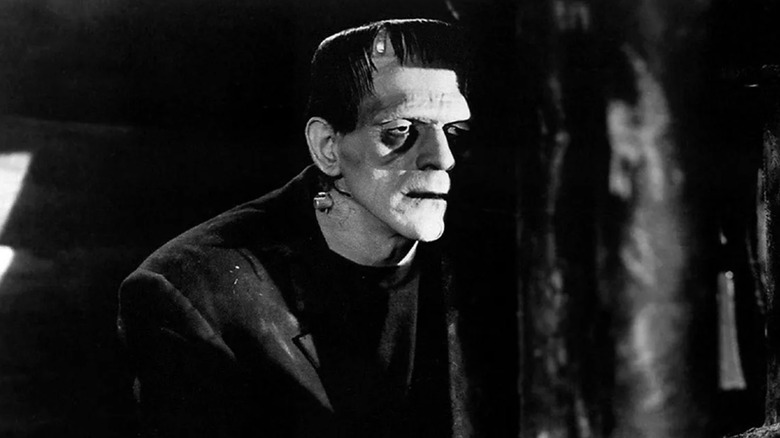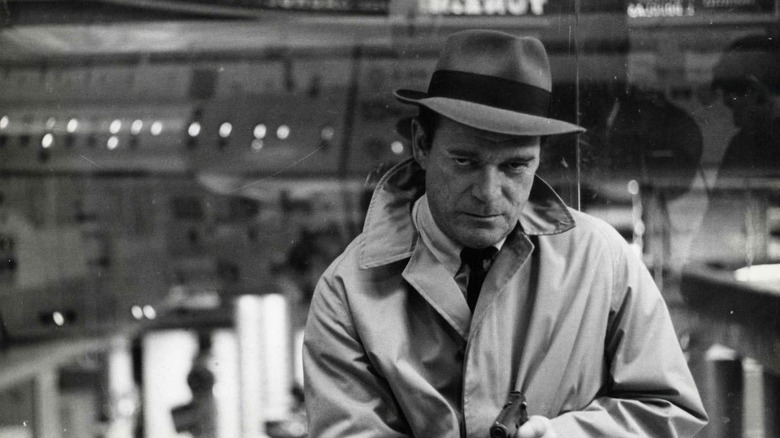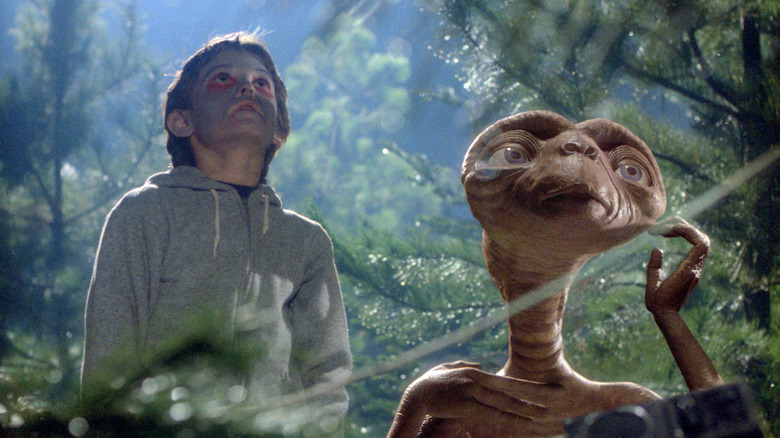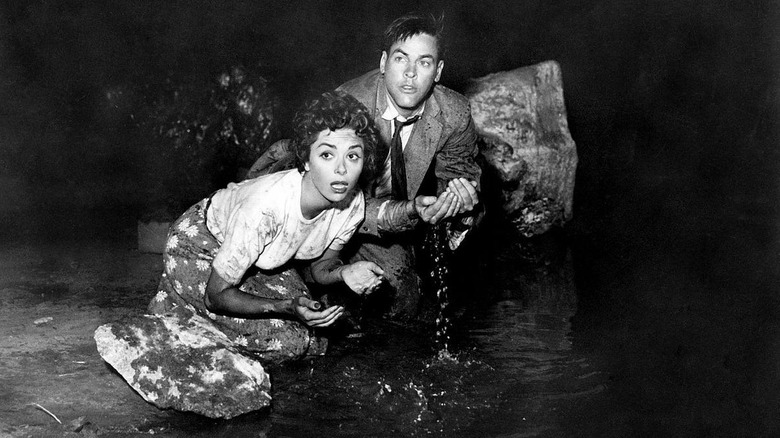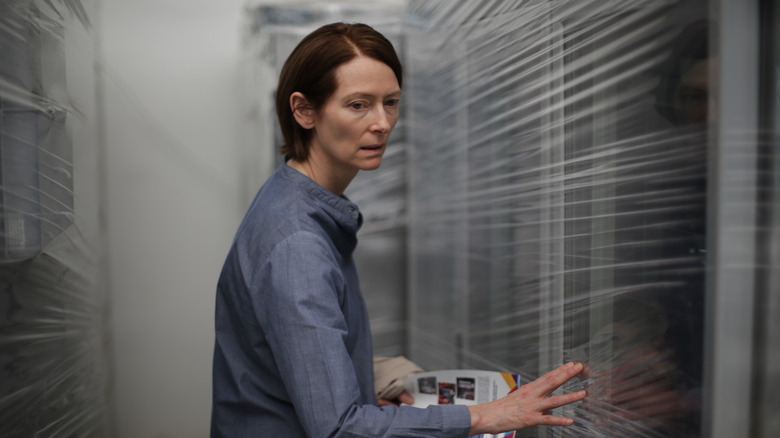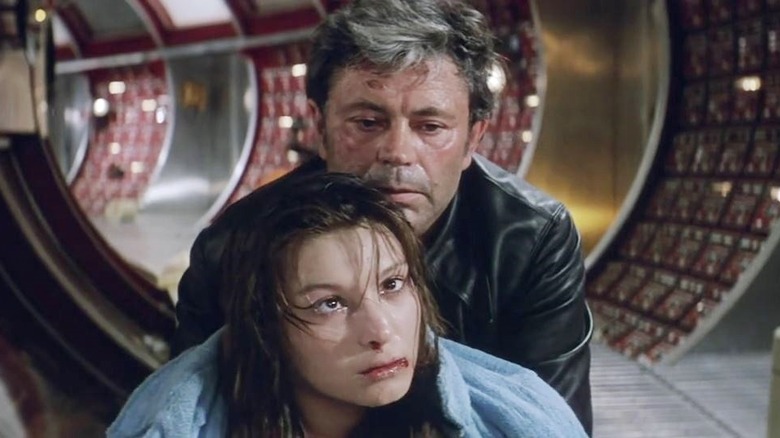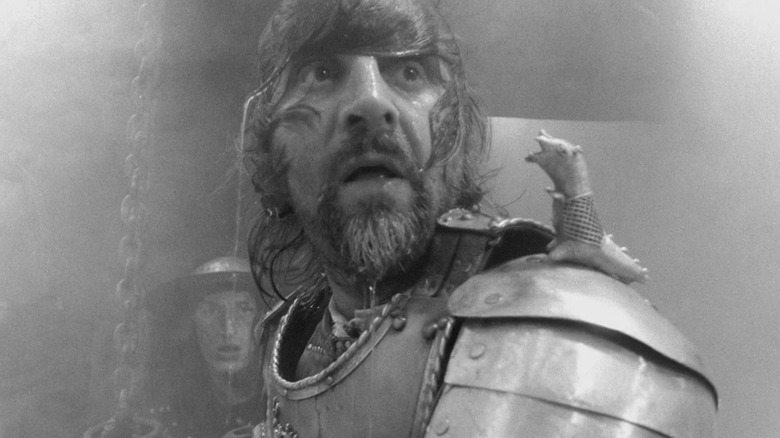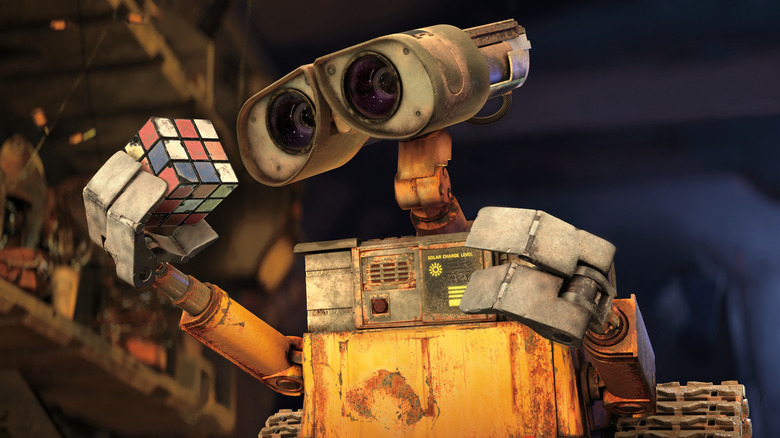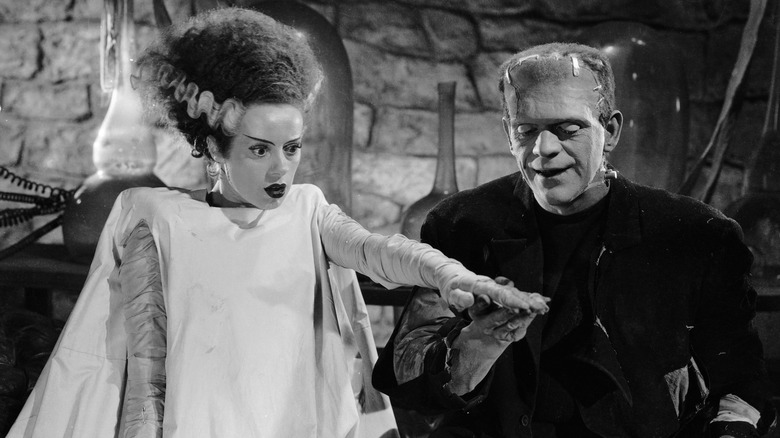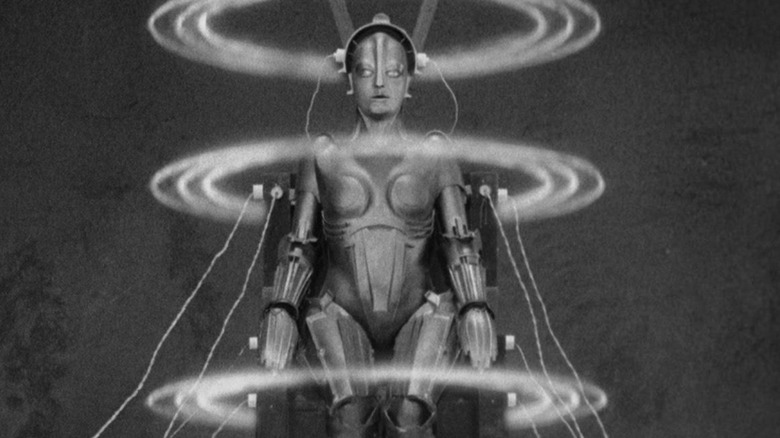There Are 16 Near-Perfect Sci-Fi Movies According To Metacritic
On a quiet night in, you may find yourself scrolling through your favorite streaming service, looking for a good movie to watch. The full selection is overwhelming, so you decide to filter it by genre. When you choose a genre from the menu, what you're really doing is deciding, "What do I want tonight's movie to make me feel?" We expect action to thrill us, comedy to make us laugh, and romance to tug on our heartstrings. But science fiction isn't like other genres — sci-fi can make you feel all kinds of things. It's malleable, versatile, able to combine elements of other genres together into unique settings and situations while challenging you to examine your world in a new way.
According to Metacritic's review score algorithm, which is based on a weighted average of selected film critics' grades for a given film, there are 16 nearly perfect science fiction films in history, each with a score of 90 or higher out of a possible 100. What's fascinating about this selection is its diversity. These films hail from different countries and are even created in totally different media, spanning nearly the entire history of cinema. While two directors appear on the list twice, Metacritic's top sci-fi movies otherwise have very little in common. Some will make you laugh, some will make you cry, some will put you on the edge of your seat — but they each begin by taking some fantastic yet plausible leap of imagination.
Star Wars: Episode IV - A New Hope
"Star Wars." Perhaps you've heard of it? The 1977 original that we now call "Episode IV" turned Hollywood completely upside down, becoming the highest-grossing film of all time and holding that record until it was dethroned by "E.T. the Extra-Terrestrial" in 1982. It's since spawned a massive franchise that has raked in over $5 billion in ticket sales alone. The initial critical response was mixed ("O dull new world!" cried New York magazine), but the masses who spoke so loudly with their dollars have since been vindicated with near-universal acclaim in hindsight, leading to its Metascore of 90.
"Star Wars" represented a quantum leap forward in filmmaking technology, dazzling audiences with visual effects the likes of which they'd never seen. But motion control starship effects aren't the only driving force behind director George Lucas' greatest achievement; it's a fictional world that feels so real that viewers can't help but become absorbed in it.
Today, the "Star Wars" universe has become so expansive and popular that you can actually visit it at Disney parks. There's no greater example of science fiction's escapist appeal or its versatility as a genre than "Star Wars," which combines elements of war epics, Westerns, and classic sword-and-sorcery fantasy into a sci-fi setting that has something to offer nearly anyone who decides to visit that galaxy far, far away.
It's Such a Beautiful Day
Originally released as a trilogy of shorts, "It's Such a Beautiful Day" is a mixed-media film built around pen-and-paper stick figure animations that, despite their simple forms, are remarkably expressive and sympathetic. The film tells the story of Bill, a man coping with an unnamed brain disease that is gradually destroying his memory and eroding his grip on reality. His story is told in a stream-of-consciousness style that takes the audience closely into Bill's thoughts as he examines his life, his family history, and the nature of existence. Remarkably, this animated film is the product of a single creator, Don Hertzfeldt, from its hand-drawn character performances to its narration and sound effects.
"It's Such a Beautiful Day" is a brutally dark comedy, so dark that it's hard to still call it a comedy. Vulture's Bilge Ebiri called it "one of the saddest films I've ever seen," but nevertheless ranked it among the best films of the 2010s. "Hertzfeldt's attention to the fleeting glories of existence makes you feel one with the universe," wrote Ebiri in a 2020 retrospective. But along with being profound, "It's Such a Beautiful Day" is also a deeply intimate film that makes you empathize with its crudely drawn protagonist on a level you might not think possible. It holds a score of 90 on Metacritic, where it is also ranked the No. 20 greatest animated film of all time.
Is it really a science fiction film, or just experimental? Genre is in the eye of the beholder — if Metacritic puts it in its top sci-fi rankings, so shall we.
Close Encounters of the Third Kind
In Steven Spielberg's 1977 "Close Encounters of the Third Kind," electrician Roy Neary (Richard Dreyfuss) becomes obsessed with the search for extraterrestrial life after having a run-in with a low-flying UFO. Neary discovers that he and a number of other UFO witnesses have been sharing strange visions, leading them on a daring quest for the truth. While not a marathon of effects-heavy set pieces like "Star Wars," which was released that same year, "Close Encounters" features one of the most arresting finales in sci-fi history, a testament to the simple joy and beauty of communication.
"Close Encounters" is an adventure story that's light on action but heavy on suspense, intrigue, and wonder, keeping the story grounded in the point of view of everyday people rather than the scientists and soldiers closest to the action. "Spielberg seems to be whispering, 'This is going to scare you, but don't be afraid,'" wrote Gary Arnold in his contemporary review of the film for The Washington Post. "Spielberg puts on an enchanting magic show, springing one sensuous and sentimental highlight after another."
Authentic performances, groundbreaking effects, and a gorgeous John Williams score have made "Close Encounters" an enduring favorite among critics, and it boasts a Metascore of 90. The film was nominated for seven Academy Awards, winning for cinematography and sound effects editing. In 1980, after seeing Spielberg's revised Special Edition of the film, Roger Ebert called it "one of the great moviegoing experiences."
Mad Max: Fury Road
In the future of "Mad Max," an ecological disaster has left Earth bone-dry and the survivors of the apocalypse battling over the remaining supplies of water and oil. Between the original "Mad Max" in 1979 and its two sequels in the 1980s, each film in the series upped the ante on grim yet stylish over-the-top action, but director George Miller took things to a whole new level when "Mad Max: Fury Road" hit screens in 2015. "Fury Road" is an intense, non-stop chase movie in which hard-luck hero Max Rockatansky (Tom Hardy, taking over the role from Mel Gibson) teams up with the devastatingly cool Imperator Furiosa (Charlize Theron). Together, they help five women escape slavery at the hands of the revolting despot Immortan Joe (Hugh Keays-Byrne).
"Mad Max: Fury Road" is a top-notch action movie with eye-popping stunts and practical effects, not to mention award-winning costume and production design. These qualities alone were enough to earn it high praise from critics upon release. But "Fury Road" has also been held up as a feminist film in a genre (action, not sci-fi) where such themes are rare. The film's combination of brains, compassion, and pure adrenaline led to the kind of major awards recognition that genre flicks rarely receive, as well as a near-perfect Metascore of 90. It stands as an example of how sci-fi can educate and empower as well as entertain.
Her
Many of the highest-scoring sci-fi films on Metacritic are about showing the audience something big and awe-inspiring, but this entry on the list focuses on something much smaller: your cellphone. In Spike Jonze's 2013 drama "Her," Joaquin Phoenix plays a lonely man who falls in love with Samantha (voice of Scarlett Johansson), the self-aware operating system on his phone and computer. The film takes a realistic and down-to-earth approach to its premise, fleshing out the romance before gradually broadening its scope to examine the grander implications of bringing a thinking, feeling artificial intelligence into the world.
"Her" wrings a lot of humor and pathos out of its bizarre yet relatable premise, raising questions about our culture's increasing dependence on technology but also on how we relate to each other as human beings. What do we, or should we, look for in love? How much of love is about the other person, and how much is selfish? What happens when one partner needs the other more? All this feeling is centered around an awkward introvert and the shiny rectangle he carries in his pocket, brought to life by terrific, committed performances.
On top of awarding it a Metascore of 91, Metacritic found that "Her" topped 22 different lists of critics' favorite films of 2013. "Her" was also nominated for five Academy Awards, including best picture, and brought home the prestigious Oscar for best original screenplay.
Frankenstein
Mary Shelley's 1818 novel "Frankenstein" is the prototypical sci-fi work, a tale of science gone wrong with a strong moral and emotional core. You know the story well — Dr. Victor Frankenstein (Henry in the film, played by Colin Clive) attempts to conquer death by constructing a new man from the bodies of the dead and reanimating his tissue via advanced chemistry. His creature does indeed come to life, but is shunned by society for his imposing figure, his hideous visage, and his unnatural origins, leading to a tragic and violent ending.
Nothing has boosted the cultural impact of Shelley's tale so much as director James Whale's 1931 film adaptation, which redefined the story and characters of "Frankenstein" into the iconic versions most familiar to the public today. Boris Karloff's performance as the shambling, wordless creature, as well as his iconic appearance by makeup artist Jack Pierce, are now inseparable from the character. Later film adaptations featuring an eloquent, intelligent creature now just feel wrong, despite being more accurate to the source material. Karloff went on to reprise the role in three sequels, one of which appears later on this list.
The impact of "Frankenstein" was felt instantly. In his review for The New York Times, Mordaunt Hall called the film "far and away the most effective thing of its kind." Nearly a century later, critics still consider "Frankenstein" one of the pinnacles of both sci-fi and horror, and it stands tall with a Metascore of 91.
Alphaville
The French/Swiss director Jean-Luc Godard was primarily known as one of the main architects of the French New Wave movement in cinema, and his experiments with narrative structure, genre, imagery, and editing made him one of the most influential filmmakers of the 20th century. While best known for films like "Breathless," "Contempt," and "Week End," Godard also wrote and directed the 1965 film "Alphaville," a satirical fusion of sci-fi and film noir that retains a 92 rating on Metacritic and has cast an enduring shadow on later sci-fi landmarks like "Blade Runner," "THX 1138," and "Brazil."
Eddie Constantine stars as secret agent Lemmy Caution, who arrives in the futuristic city of Alphaville to ostensibly find a missing agent but whose real mission is to destroy Alpha 60, the supercomputer that controls the city and has eliminated all notions of love and individuality from its inhabitants. Although Caution is a quintessential American noir detective, complete with trench coat and fedora, Alphaville seems to exist at the nexus of several alternate realities, which Alpha 60 and its creator aim to ultimately control as well. Surreal yet pulpy, "Alphaville" is part of the same groundbreaking wave of '60s sci-fi that gave us classics like "2001: A Space Odyssey" and "Seconds."
E.T. the Extra-Terrestrial
Few sci-fi films hold such a treasured place in the hearts of those who grew up with it than Steven Spielberg's "E.T. the Extra-Terrestrial." Released in the spring of 1982, "E.T." was a massive success, drawing in families in such droves that it supplanted "Star Wars" as the highest-grossing film of all time. Like Spielberg's other sci-fi films, "E.T." features moments of eerie suspense and exciting adventure, but it also has something going for it that most genre blockbusters don't: It's adorable.
"E.T." tells the story of Elliot Taylor, played by 10-year-old Henry Thomas, and a benign alien visitor represented by an advanced animatronic and performed by a variety of puppeteers and costumed actors. Made long before CGI became de rigueur, E.T. is so emotive and charismatic that it takes no time to forget that he's a special effect. As the bond between Henry and E.T. grows, so does E.T.'s bond with the audience. When his time on Earth takes a toll on E.T.'s health, you'll likely find yourself genuinely concerned, even anguished with worry over his well-being.
E.T. was a hit with critics upon its release, and continues to tug on their heartstrings today. "How old is too old to sob like a little girl at 'E.T. the Extra-Terrestrial'?" asked Christy Lemire of The Philadelphia Inquirer in 2012. "Not 40, apparently." The film has soared to a Metascore of 92.
Invasion of the Body Snatchers
In the 1950s, alien invasion stories were all the rage in Hollywood. It was the nuclear age, a time when the wonders of outer space felt closer than ever, as did the threat of subversion or conquest by those devious Soviets. Extraterrestrials on film became a way to personify this cultural anxiety, as in "The Thing From Another World," or to criticize it, as in "The Day the Earth Stood Still." Depending on who you ask, the original 1956 version of "Invasion of the Body Snatchers" does both, or neither.
"Invasion of the Body Snatchers" is a thriller following two suburbanites who discover that their neighbors are being secretly replaced, one by one, with identical copies of alien origin bent on world conquest. The tension grows as they begin to question whether there's anyone left in town — even their closest friends — who are still who they appear to be.
Jack Finney, the author of the novel on which the film is based, claimed that there was no political purpose behind his story at all, as did director Don Siegel, but regardless of intent, the film is soaked in the paranoia of its day. Time Out's 2014 retrospective review explains: "From fascism to communism to capitalist conformity ... this is the perfect distillation of uncanny existential terror." Critics thought little of "Invasion of the Body Snatchers" in 1956, but, generations later, it has risen to a Metascore of 92.
Memoria
"Memoria," from Thai director Apichatpong Weerasethakul, is perhaps the most enigmatic film on our list. It debuted in July 2021 at the Cannes Film Festival, where it was awarded the Jury Prize, one of the event's highest honors, but its theatrical release was extremely limited. This is particularly true in the United States, where it screened as a touring art exhibit, playing on only one screen at a time. But those critics who have seen it have heaped praise aplenty upon the film, winning it a Metascore of 92. A.O. Scott of The New York Times described it as "an emotionally wrenching and intellectually fulfilling experience." Polygon's Robert Daniels called "Memoria" "a sensory explosion [whose] dense, immersive shrapnel isn't easily removable," though he also warned that it may be "too metaphor-heavy to wholly hit its emotional target."
"Memoria" is the story of Jessica (Tilda Swinton), a Scottish woman living in Medellin, Colombia, who is haunted by a thunderous recurring sound that only she can hear. Jessica struggles to understand the sound and searches for a way to free herself from it, but it's not so much a mystery as it is a character study and existential meditation. "Memoria" is deliberately disorienting and opaque, with a conclusion that The Los Angeles Times' Justin Chang said "left [his] jaw on the screening room floor."
"Memoria" may not be every sci-fi enthusiast's cup of tea, but it's a must-see for fans of art house cinema — that is, if it's ever playing near you.
Solaris
In Andrei Tarkovsky's 1972 film "Solaris," a psychologist is sent to investigate a space station whose entire crew has suffered some sort of emotional breakdown. While initially dismissing their reports of bizarre visions as mere hallucinations, the psychologist soon finds himself face to face with his late wife. What is she, really? Has the strange ocean planet below somehow reunited them, or is she some sort of illusion? And even if she is, can they still be in love?
"Solaris" draws easy comparisons to "2001: A Space Odyssey," another slow, deliberate, and visually stunning art film set in space. But, as Roger Ebert wrote in a retrospective review, "['2001'] is outward, charting man's next step in the universe, while ['Solaris'] is inward, asking about the nature and reality of the human personality." The film has an intriguing sci-fi conceit in its titular sentient planet, which attempts to communicate to the humans above using their own memories. But as in most great speculative fiction, the otherworldly element is just a device through which to explore the characters, and by extension, the audience.
"Solaris" premiered at the 1972 Cannes Film Festival, where it won the Grand Prix Spécial du Jury (its second-highest honor) and was nominated for the Palme d'Or (its highest). An American remake was produced in 2002, directed by Steven Soderbergh, but is not as highly regarded, with a Metascore of 65 to the Tarkovsky version's 93.
Hard to Be a God
Not every great science fiction film is a blockbuster hit. Russian director Aleksei German's 2013 adaptation of Arkady and Boris Strugatsky's novel "Hard to Be a God" grossed just under $1.3 million worldwide. It is an opaque and difficult watch even in the eyes of those who love it. A.V. Club critic Ignatiy Vishnevetsky wrote, "If 'Hard to Be a God' isn't the filthiest, most fetid-looking movie ever made, it's certainly in the top three." "What on earth does it mean?" asked The Guardian's Peter Bradshaw, who gave it five stars. In the judgment of these critics and many more, whose reviews have won the film a Metacritic score of 93, "Hard to Be a God" is a challenge worth accepting.
The plot of "Hard to Be a God" reads like a cautionary tale out of classic "Star Trek," though the novel predates the series by a few years. A team of scientists is dispatched to an Earth-like planet whose social and technological development are centuries behind our own, held back by a stubborn and violent anti-intellectualism. The protagonists are tasked with anonymously kickstarting the culture's progress, an effort that is repeatedly met with disaster and disappointment.
Do not approach "Hard to Be a God" expecting anything conventional. Telegraph's Robbie Collin warned that the film "[refuses] to take any recognizably plot-like shape," but assured that an open-minded viewer will find it "exhilarating, moving, funny, beautiful[,] and unshakeable."
WALL-E
Some sci-fi movies are beloved for the implausible journeys they take us on, for the high emotion they can inspire, for the lessons they teach about our real lives, or for the way they push the technological limits of cinema. "WALL-E" is the rare film that excels in all of these departments. It's a visually stunning computer-animated film with a heart of gold and something worthwhile to say. The brainchild of director Andrew Stanton and the celebrated Pixar animation studio, "WALL-E" has "something for everyone" in the best way.
The titular character of "WALL-E" is one of Earth's last "living" inhabitants, and has one programmed purpose — to crush garbage into compact, stackable cubes. After years in isolation, he grows beyond his programming, dreaming of romance and adventure. WALL-E gets his wish when he discovers a living plant among the ruins of our spoiled planet and falls in love with EVE, the advanced probe tasked with returning the plant to humanity's new home in space. Throughout their journey, the film dazzles with beautiful animation and production design, and comments on modern consumerism and reliance on technology, all the while remaining a romantic comedy at heart.
"WALL-E" drew instant critical acclaim. New York magazine's David Edelstein called it "a masterpiece to be savored before or after the end of the world." It was nominated for seven Academy Awards, winning best animated feature, and with a Metascore of 95, ranks in Metacritic's top 10 animated features of all time.
The Bride of Frankenstein
Director James Whale's "Frankenstein" shocked new life into both horror and science fiction in 1931, but it's his sequel, 1935's "The Bride of Frankenstein," that stands as his true masterpiece, besting the original by four points for a Metascore of 95. In "Bride," Dr. Frankenstein's (Colin Clive) mentor Dr. Pretorius (Ernest Thesiger) coerces him into harvesting more dead bodies with which to create a mate for the lonely creature (Boris Karloff). Meanwhile, the creature wanders the countryside searching for meaning or companionship, only to have it stolen from him at every opportunity by closed-minded citizens.
"The Bride of Frankenstein" builds on the horror of the first film while also adding a charming self-awareness and humor. Whale mines both scares and laughs from the creature's misadventures, and Dr. Pretorius is camp incarnate. The film is full of moments and images that have since become so iconic that some may assume they originated in the previous film, such as the creature's grunts and broken speech or his friendly encounter with the blind hermit. The bride herself (Elsa Lanchester), with her statically charged hairdo, is one of the most famous figures in the genre despite appearing only briefly in the film.
Initially praised as merely "a first-rate horror film," "The Bride of Frankenstein" is now regarded a classic, as well as a favorite subject of study as a work of gay cinema.
Gravity
We want movies, and sci-fi movies in particular, to take us places. "Gravity" takes us to Earth orbit — one of the deadliest, most beautiful places any human has ever gone — and then holds us there, relentlessly, for about 90 minutes. The film stars Sandra Bullock as Dr. Ryan Stone, an astronaut whose spacewalk is interrupted when a sudden barrage of orbital debris destroys her shuttle. Alone in the vacuum of space, Dr. Stone must find a way to rendezvous with another craft before her air runs out or the debris field comes back around and tears her apart.
Director Alfonso Cuarón takes great pains to keep the audience totally immersed in the events of the film. The story plays out in just about real time, and with as few cuts as possible. "Gravity" begins with a 13-minute continuous take that sets the tone for the entire film, in which the camera floats through space and rarely leaves Ryan's side.
The technological challenges of creating "Gravity" meant it took over four years to complete, and the final product stands up as one of the greatest examples of what IMAX 3D can bring to a film. Much of what you see in "Gravity" is computer-generated, but Bullock's performance is very real, earning her an Academy Award nomination for best actress. The film would go on to win seven Oscars, including best director for Cuarón, and maintains an astronomical Metascore of 96.
Metropolis
Metacritic's highest-scoring science fiction film (with a Metascore of 98) dates all the way back to 1927, during the first golden age of cinema — the silent era. The brainchild of German director Fritz Lang and screenwriter/novelist Thea von Harbou, "Metropolis" is the story of a conflict between the suffering workers and the pampered ruling class of a massive futuristic city. Much of the story centers around Freder (Gustav Fröhlich), the son of the city's "master" who joins with the workers when he learns of their plight. The star of the show, however, is Brigitte Helm in the dual role of Maria, the kind-hearted leader of the workers, and the Maschinenmensch, the wicked robot created in her image to incite a war between the factions.
"Metropolis" was not a critical smash when it was first released. New York Times film critic Mordaunt Hall called it "a technical marvel with feet of clay, a picture as soulless as the manufactured woman of its story." But later generations were kinder to the film, fixating on its revolutionary special effects and unique production design, as "Metropolis" became a key influence on later sci-fi classics like "Star Wars" and "Blade Runner." Scarcity also contributed to the legacy of "Metropolis," as only abbreviated cuts (down from two and a half hours to about 90 minutes) were available for most of the 20th century. Its 2003 restoration was celebrated by modern film critics, leading to its near-perfect Metascore. Only 14 films have scored higher.


